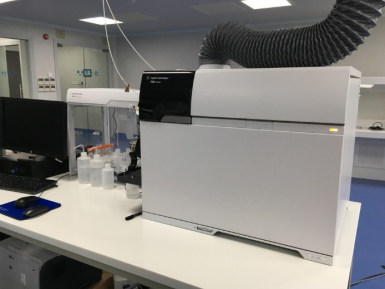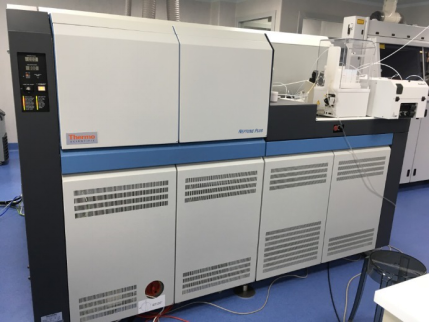Introduction
The LA-MC-ICPMS Laboratory was set up in 2016, and is opened mainly to academic users for the measurements of trace elements and various isotope ratios in diverse materials and fields.
The LA-MC-ICPMS Laboratory comprises a class 1000 temperature and humidity controlled clean room for instruments and a class 100-1000 clean room for chemical pretreatment.
The laboratory comprises four major instruments: Inductively Coupled Plasma Mass Spectrometry(ICPMS), Laser ablation system (LA), Multi-Collector Inductively Coupled Plasma Mass Spectrometry (MC-ICPMS) and H-O isotopic analyzer.
1. ICPMS (Agilent, Model 7900)
The quadrupole ICPMS with collision cell uses innovative technology and a new MassHunter software. The matrix tolerance has been extended which can measure samples containing up to 25% TDS. The instrument boasts a linear dynamic range of up to 11 orders of magnitude (from sub-ppt to %-level concentrations), as well as the helium (hydrogen) collision mode are applied to minimize interferences. Itdelivers superior-quality data with minimal drift and high precision (RSD<5% at low ppb level). When connected with laser ablation system, it is capable of in-situ elements analysis and U-Pb dating.

2. Laser ablation system (ASI resolution, Model LR)
The ArF 193nm gas excimer laser is controlled with Geostar software and configured with squid coil to smooth out the signal on sample introduction line. It can be used for various in-situ elemental and isotopic analysis. Sample holders can be adapted to the thin section, 1 inch round shape and universal shape. Five different ablation modes are available including single spots, transects and mapping. Various standards are available including NIST standards, USGS and MPI-DING reference glasses.

3. MC-ICPMS (Thermo Fisher Scientific, Model NEPTUNE plus)
The Neptune plus is a double focus magnetic sector instrument that is fitted with 9 Faraday detector, 3 SEM and 4 CDD (Compact Discrete Dynamic SEM) to allow the vast majority of isotopes in the Periodic Table to be measured for Earth, environmental, biological, archaeological sciences and so on. An automatic sample introduction system allows for high precision and high throughput isotope analysis of many elements, from lithium to uranium. Analytical protocols for Sr, Nd, U, Li, Si isotopes are already set up, and protocols for other isotopes will be set up following research need. When connected to the laser system, it is capable of highly efficient in-situ U-Pb dating and Hf isotopes of zircon and other high U-Pb/Hf materials.

4. H-O isotopic analyzer(LGR, Model TIWA-45EP)
The Hydrogen and Oxygen Isotopic Analyzer designed by American Los Gatos Research Company (LGR) was developed for stable isotope analyses (i.e., δD, δ17O and δ18O) of liquid and vapor water. The advanced Off-axis integral cavity output spectroscopy coupled with optical cavity ring-down spectroscopy was used to improve the precision and efficiency. About 180 samples can be finished per day, including 150 unknown samples and 30 standard samples. Each test sample will be calibrated by three standards in the post analysis software provided by LGR, and the data (i.e., δD, δ17O and δ18O) can be attained with a typical precision of 0.5‰, 0.1‰, 0.1‰, respectively.

Contact Person:Juan Xu
Email:juanxu@tongji.edu.cn

